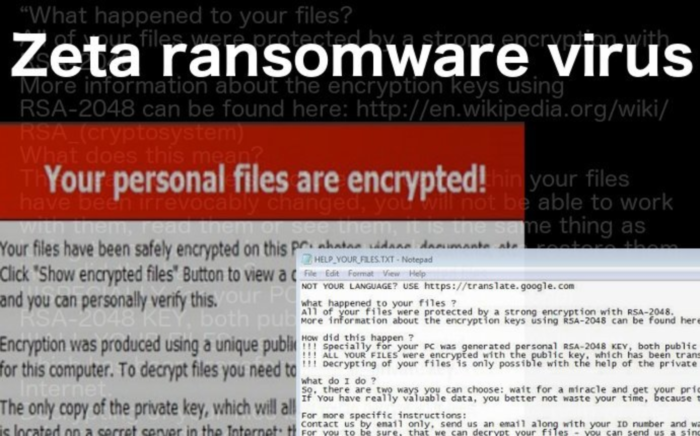What is Zeta ransomware?
Zeta ransomware is yet another encryption virus that appeared at a time when a this type of hazard became extremely widespread. Among all malware threats ransomware is probably the most dangerous one, as it targets for the data stored on a system and makes it unreachable until a victim pays the ransom. Under this category may fall personal media files, important documents and other data that users usually put more value on. After a successful detection and encryption of this information Zeta ransomware notifies the victim and lays down the demands which come down to transferring the money in the amount of 0.5-3 BitCoins (220-1500 USD). In exchange for that cybercriminals bid fair to provide a unique decrypting key that will allow retrieval of all information. However, these are only the words of the cyber criminals that don’t provide guarantees, so you need to remember that there is a chance that you will pay money for nothing only encouraging malware developers to further activities. So, first we recommend to make attempts to remove Zeta ransomware on your own, instructions for that you may find below.

Symptoms of Zeta ransomware infection
It’s difficult not to notice ransomware, since it often has one of the processes responsible for displaying a notification message. This window blocks the screen leaving the user minimum alternatives. Besides, some files will be inaccessible, as in many cases ransomware encrypts them to exasperate the scaring effect.
How Zeta ransomware got installed on your computer
It is always better to prevent infection than to fight it, so you should know the ways of Zeta ransomware distribution. For it not to infiltrate your PC, avoid visiting shaddy resources and notifications about software updates that they often produce. Also, you may encounter tempting banners or pop-ups offering system repairment or bargain deals – don’t click them as they might trigger installation of malware. If you are not sure whether you system needs updates or has health issues, it’s better to use a reliable antivirus/antimalware tool and download the updates only from the official websites.
What to do if your PC is infected with Zeta ransomware
As soon as you notice the presence of the ransomware on your system, you should turn your computer off. If it is possible try to create a backup or image of your hard drive info. This may let you to reserve the state of your drives in case a decryption method would be created afterwards.
How to remove Zeta ransomware?
To make sure that the adware won’t reappear, you need to delete Zeta ransomware completely. For this you need to remove the files and registry entries of the ransomware. We should warn you that performing some of the steps may require above-average skills, so if you don’t feel experienced enough, you may apply to automatic removal tool.
Steps of Zeta ransomware manual removal
Restart Windows in Safe Mode
For Windows XP:
- Restart the system
- While computer is rebooting press F8 several times
- In the appeared list of options choose Safe Mode
For Windows 7 and Vista:
- Restart the system
- While computer is rebooting press F8 several times
- In the appeared list of options choose Safe Mode
For Windows 8 and 8.1:
- Restart the system
- While computer is rebooting press F8 several times
- In the appeared list of options choose Safe Mode
For Windows 10:
- In the Start menu click on the power button
- Hold Shift and choose Restart
- Choose Troubleshoot
- In the Advanced Options choose Startup Settings
- Click Restart
- Select Enter Safe Mode
Restore the files encrypted by Zeta ransomware
Use the decrypting tool
Unfortunately, currently a tool able to decrypt the files infected by Zeta ransomware is not released yet. You may try applying to the methods described below, however, they might not work with the latest versions of Zeta ransomware.
Restore the system
- Initiate the search for system restore
- Click on the result
- Choose the date before the infection appearance
- Follow the on-screen instructions
Roll the files back to the previous version
- Right-click the file and choose Properties
- Open the Previous Version tab
- Select the latest version and click Copy
- Click Restore




